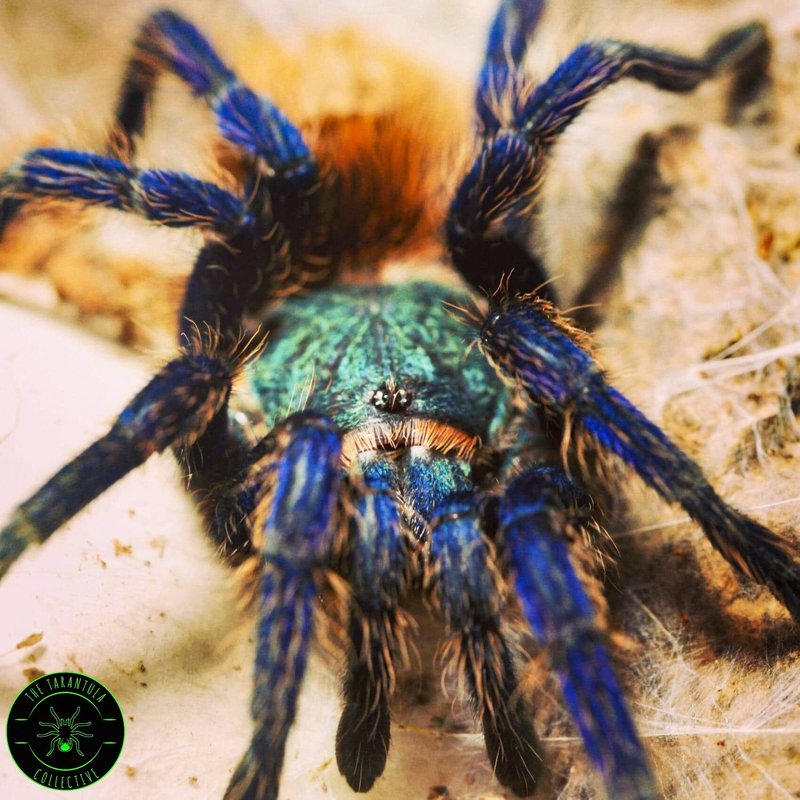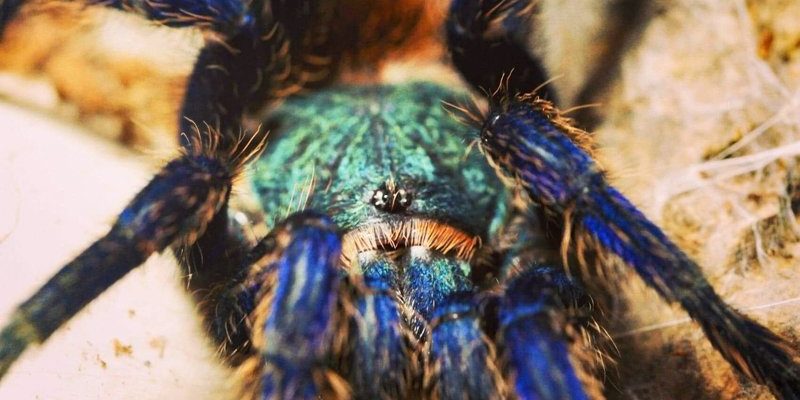
Identifying a Greenbottle Blue Tarantula can be a bit tricky if you’re new to these creatures. But fear not! Whether you’re a budding arachnologist or just someone curious about the world of spiders, I’m here to guide you through the process step by step. Grab a cup of coffee and let’s dive into the colorful world of this remarkable tarantula.
Physical Characteristics of the Greenbottle Blue Tarantula
When trying to identify the Greenbottle Blue Tarantula (*Haplopelma lividum*), the first thing you’ll notice is its vibrant coloration. Adult specimens feature striking electric blue legs and a bright greenish carapace that glimmers in the light. As juveniles, however, they might have a more muted appearance, which can be confusing for new enthusiasts. The vibrant colors develop as they mature, so don’t be alarmed if you initially spot a duller version of these stunning spiders.
Another essential feature to look for is the size. Greenbottle Blue Tarantulas are medium to large, with a leg span that can reach up to 5–6 inches. Their body is robust, giving them a hefty appearance compared to other tarantula species. If you’re looking up close, check out the eye arrangement—these spiders have eight tiny eyes, arranged in a curved line. This arrangement can help differentiate them from look-alikes.
Understanding Their Behavior
You might be wondering about the behavior of the Greenbottle Blue Tarantula, and here’s the thing: they have quite the personality! Unlike some tarantulas that prefer to hide, the Greenbottle Blue is known for being relatively active. They tend to build silk retreats in their environment, where they can feel safe while observing their surroundings.
When you first approach a Greenbottle Blue, it might retreat to its silk sanctuary or display a defensive posture, raising its front legs as if to say, “Back off!” This behavior is completely normal. They can be a bit skittish, especially if they feel threatened. So, if you’re planning to observe or handle one, do so with caution and respect.
Habitat Preference
These tarantulas thrive in a specific type of environment, typically found in tropical rainforests. They prefer warm and humid conditions, much like a cozy tropical vacation! Greenbottle Blues tend to burrow underground, creating elaborate webs that serve as both homes and traps for unsuspecting prey.
If you’re looking to keep one as a pet, replicating their natural habitat is crucial. This includes maintaining a warm temperature (around 75-85°F) and keeping the humidity levels between 70-80%. You might find that incorporating peat moss and wood pieces for climbing will create a more comfortable living space for your new eight-legged friend.
Handling and Care Considerations
Now, if you’re thinking about bringing a Greenbottle Blue Tarantula into your home, there are some important care tips to keep in mind. Firstly, be aware that these tarantulas can be more defensive than others. Handling them frequently isn’t usually recommended, especially if you’re a beginner. They might be beautiful, but their temperament can be unpredictable.
If you do choose to handle your Greenbottle Blue, do so gently and with confidence. Use a soft, wide container to guide them into your hand, and always support their body. It’s important to ensure they feel secure. A little patience goes a long way. If they seem stressed or agitated, it’s best to let them be.
Feeding Your Greenbottle Blue Tarantula
Feeding these tarantulas is another essential aspect of their care. In the wild, their diet mainly consists of insects, such as crickets, roaches, and mealworms. When keeping them in captivity, you can replicate this diet easily. Adult Greenbottle Blues typically eat 2-3 insects per week. Just remember—don’t overfeed!
You’ll want to ensure that the prey is appropriately sized, meaning it shouldn’t be larger than the width of the tarantula’s body. This helps prevent any unnecessary stress or injury to your spider. Setting a consistent feeding schedule is a good idea, as it helps maintain a healthy feeding routine.
Common Misconceptions
Many people have misconceptions about tarantulas in general, and the Greenbottle Blue is no exception. One common myth is that these spiders are highly aggressive. While they can exhibit defensiveness if threatened, it’s not accurate to label them as aggressive. Their behavior often stems from a desire to protect themselves rather than an inclination to attack.
Another misconception is that tarantulas are dangerous to humans. The truth is, while their bites can be painful, they are not deadly. Most bites result in localized pain and swelling, similar to a bee sting. So if you ever find yourself face to face with one, remember they’re more scared of you than you are of them!
Identifying the Greenbottle Blue Tarantula may seem daunting at first, but with a little practice and observation, you’ll be well on your way. Keep an eye out for their vibrant colors, unique behavior, and habitat needs, and you’ll have a better understanding of this stunning creature. Whether you’re just a curious observer or considering one as a pet, appreciating their beauty and quirks can bring a little more wonder into your life.
So, next time you spot a Greenbottle Blue Tarantula, you’ll know just what to look for. Remember to respect their space, observe their behavior, and enjoy the colorful world they bring to our lives!

